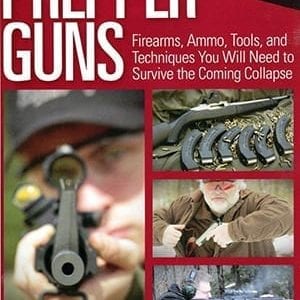 It’s never too soon to start thinking about next deer season. If you hunt public land you understand frustration. Here is a technique that can lead to success, but the time for scouting locations is now.
It’s never too soon to start thinking about next deer season. If you hunt public land you understand frustration. Here is a technique that can lead to success, but the time for scouting locations is now.
Time and again I have heard that you need to stay out of a buck’s bedding area because if you disturb him there, he will abandon it and perhaps move out of your hunting area. Good advice if you have a lot of private land with no hunting pressure. But, if like most of us you are hunting public land, it hardly applies. Where is he going to go? The next place is just as crowded and in between are a lot of guys gunning for his horns. It’s a dangerous world out there and that buck knows if he starts moving around in the daylight hours he will quickly become burger.
A smart buck will spend the days avoiding hunters, sleeping in some hidey hole. That hidey hole is his bedding area and if he refuses to leave it in daylight hours, you need to execute a home invasion to extract him.
So how do you find his bedding area? Well, you lay down some tracks. I like to spend some time when deer season is closed looking at all those places I didn’t get to hunt and trying to locate the bedding areas. Or if the hunting season is still open and you are not having any luck, burn up a day or two finding out where they hiding.
Look in the nastiest, most inhospitable land you can find. Places other hunters avoid. Thick brush with lots of thorns, steep mountainsides with ledges or even deep in a murky swamp. I once was hunting a buck for a week without ever seeing him. Then one cold morning, late in the season, when everything was frozen solid, I followed his tracks deep into a beaver bog. He was lying up on the only clump of dry ground in a hundred acres. Seems he didn’t mind getting his feet wet to avoid new holes in his hide.
I didn’t get him that morning, but I learned where he lived. The next year I went in before the season with hip boots and a tree stand and he never stood a chance.
The best way to do this is to have your stand in a tree well in advance of the hunting season and then never use it until the bucks are feeling the pressure. But if it’s already hunting season, walk in there with the stand and run him off. Then place the stand as quickly as possible and without cutting anything visible from the ground, including shooting lanes. Cutting any brush is a very bad idea. Don’t hide the noise while leaving, give it a day or two and go hunt him.
This is not an easy way to hunt deer and it’s going to extract a price from you to do it right. So, before you start ask yourself, “How bad do I want it?”
 The key is to go in the dark while he is out feeding and get into your stand at least an hour before it is even thinking about getting light again. You must approach your stand carefully and you need to plan out your travel so that your scent is not where the buck will be traveling back through or sleeping. That means you might have to take the “long” way around and come through some nasty stuff. Avoid the temptation to use the deer trails you find; because, well, who do you think made those trails? Guess who is going to be walking on them soon? Of course, you must wear rubber boots and use all the other scent control tricks, but you can never eliminate all your scent. A buck’s nose is extremely sensitive and the only way to fool it 100% of the time it is to not go where the nose will be.
The key is to go in the dark while he is out feeding and get into your stand at least an hour before it is even thinking about getting light again. You must approach your stand carefully and you need to plan out your travel so that your scent is not where the buck will be traveling back through or sleeping. That means you might have to take the “long” way around and come through some nasty stuff. Avoid the temptation to use the deer trails you find; because, well, who do you think made those trails? Guess who is going to be walking on them soon? Of course, you must wear rubber boots and use all the other scent control tricks, but you can never eliminate all your scent. A buck’s nose is extremely sensitive and the only way to fool it 100% of the time it is to not go where the nose will be.
You are waiting for the deer to return and if you are very lucky you will shoot him at first light. But, if you don’t kill him, you can’t leave the stand until after he has gone out to feed again that night, which means waiting at least an hour after it gets dark. So you are pretty much there for the entire day. If the buck discovers you are there hunting him, he may abandon the area.
 I hate treestands and for me this is a glimpse of what hell must be like, but they can be very effective, so I am willing to endure the torture.
I hate treestands and for me this is a glimpse of what hell must be like, but they can be very effective, so I am willing to endure the torture.
It is absolutely imperative that you make no noise all day. The buck is going to be close by and he will hear you. Scent can also be a problem, but there is not a lot you can do other than work the prevailing wind when you place the stand and stay as clean as possible. Leave nothing on the ground; bring it all up in the tree. Get as high as possible.
Even if you miss the buck in the morning, they are not like humans where we go to bed and stay put for eight hours. Deer will often move around during the day, going from bed to bed, but staying within the safety of the hiding spot, so the beds are usually close to each other. Stay focused; it can happen at any time.
If another hunter wanders in and spooks the buck out of there, just sit tight. He will be back. Often they just run enough to get away and then they circle back, downwind, wait for the bozo to leave and go right back to bed.
If you picked your spot well and didn’t do anything foolish, he might just walk right into your crosshairs.
 One key to success with this “home invasion” technique is to get as high in the tree as possible. This keeps your scent off the ground and lets you look down into the thick stuff where the buck is living. It might also build in a little forgiveness for the inevitable noises that you are going to make.
One key to success with this “home invasion” technique is to get as high in the tree as possible. This keeps your scent off the ground and lets you look down into the thick stuff where the buck is living. It might also build in a little forgiveness for the inevitable noises that you are going to make.
The downside is that shooting a buck from high up in a tree, particularly when he is right below you, is very tricky business. The shot probably won’t be a long one, but when viewed from the top a buck isn’t much wider than a zipper. Plus, with all the brush, you will need to pick a hole to shoot through to make sure you don’t hit a branch. Also, you will be shooting at an angle you are not used to and the point of impact might be a lot different than you expect.
So, in the off season find a similar tree in a different place and put your treestand up just as high. Then have a buddy on the ground move a target to a bunch of different spots while you shoot at it. A 3-D archery deer target works great, but you may have to put some sticky-back targets on it to show hits. It will probably be an eye-opening experience and you should expect to miss a bunch until you get it figured out. Better now, than when it’s for real.
 The best rifle will have the scope mounted low and close to the bore. This keeps the bullet’s path closer to the line of sight. A sharp, bright, low power scope is good for seeing those hidden, bullet-deflecting branches that elude the naked eye. Make sure that you can take the safety off without making any noise, as the buck will probably be close. Also make sure that nothing rattles when you move the gun. Watch out for squeaky sling swivels.
The best rifle will have the scope mounted low and close to the bore. This keeps the bullet’s path closer to the line of sight. A sharp, bright, low power scope is good for seeing those hidden, bullet-deflecting branches that elude the naked eye. Make sure that you can take the safety off without making any noise, as the buck will probably be close. Also make sure that nothing rattles when you move the gun. Watch out for squeaky sling swivels.
Remember, this buck is going to be wired pretty tight after dealing with hunters all fall and he will not let you get away with even one small mistake.





